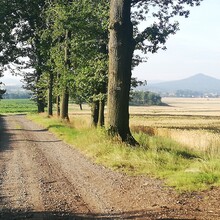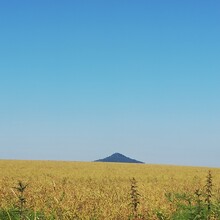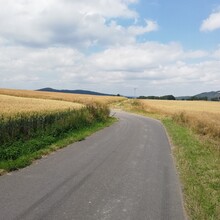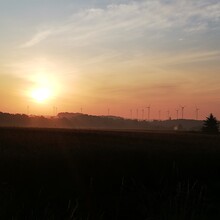*1) Between Jawor and Jelenia Góra in Lower Silesia, in the region of the Kaczawskie Mountains and Foothills, there is the Land of Extinct Volcanoes - one of the most geologically and tectonically diverse areas in Poland.
They are log mountains with sunken ditches and raised logs. The oldest rocks that make up the Kaczawskie Mountains come from the Cambrian and are over 500 million years old. The volcanic landscape of the Kaczawskie Foothills can be admired thanks to the presence of basalt hills of former volcanoes.
Geological processes, including earth movements and volcanic eruptions, have led to the creation of a huge wealth of valuable rocks and minerals. You can find here: pyrite, azurite, malachite, galena, native silver, agate, amethyst, rock crystal, ruby, zircon, garnet, corundum, topaz, tourmaline, titanite, emerald, gypsum and many others. There is even gold in river sediments.
Volcanic souvenirs
An example of the oldest volcanism in this area is a natural monument - the famous huge Wielisław Organ in Sędziszowa, dating back about 250 million years. Volcanic processes have also led to the formation of volcanic chimneys building Ostrzyca, known as the Silesian Fujiama, with a unique basalt sandstone protected by the Ostrzyca Proboszczowicka reserve. Ostrzyca is also a beautiful vantage point (501 m above sea level), the highest in the area.
Very interesting is the "Wilcza Góra" Reserve, which includes a quarry in which basalt was mined from an active volcano chimney 17 million years ago. He revealed rocks of extraordinary beauty, resembling rose petals. It is also worth visiting Czartowska Skała - an interesting basalt mountain with a volcanic past.
There are also metal ores in the Kaczawskie Mountains - copper, lead, silver and iron, which were mined here since the Middle Ages. The most famous, however, are the most beautiful Kaczawa agates in the world, which were also created due to the presence of volcanic processes in this region.
Attractions in the Land of Extinct Volcanoes
A popular attraction in this land is the Grodziec Castle, which stands on a basalt mountain, a former volcano rising 389 meters above sea level. It is also worth visiting two nearby observation towers - the tower on the Basalt Mountain in Paszowice and the tower on Mount Radogost, from which there is a beautiful panorama of the Sudetes and the foothills. An observation tower is also available in Gozdno.
*2)
The Trail of Extinct Volcanoes in the Kaczawskie Foothills
The Trail of Extinct Volcanoes, about 100 km long, runs through the Land of Extinct Volcanoes, i.e. the Kaczawskie Foothills. This trail starts (or ends depending on which side you are going) in Złotoryja and ends in Legnickie Pole. It's hard to call it mountainous, it's also hard to look for mountain challenges, because these are missing. However, is this trail worth facing? I will answer this question later.
What is the Trail of Extinct Volcanoes?
The Extinct Volcanoes Trail is a tourist trail marked in yellow. As I have already mentioned, it leads from Złotoryja to Legnickie Pole, through the Kaczawskie Foothills, often called the Land of Extinct Volcanoes. The trail is about 100 km long and it passes through all the most important places related to the volcanic history of this region, and there are quite a few of them. Evidence of the volcanic origin of the heights here is visible to the naked eye, and it is not necessary to have great geological knowledge in this field. The evidence is, among others, the mountains of Grodziec and Ostrzyca, which are former volcanoes and resemble volcanoes in their shape. Other evidence are rock outcrops such as the Wielisław Organs, the Little Myśliborskie Organs, and the Devil's Rock. The Trail of Extinct Volcanoes visits all these places.
*1)
https://www.gorykaczawskie.pl/
https://www.google.com/amp/s/www.polskieszlaki.pl/kraina-wygaslych-wulkanow.htm%3famp=1
* 2)
https://www.podrozepanaszpaka.pl/2019/09/szlak-wygaslych-wulkanow-pogorze-kaczawske.html






